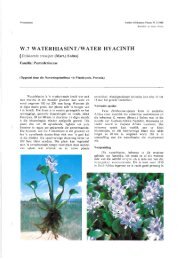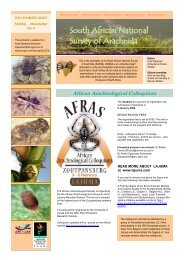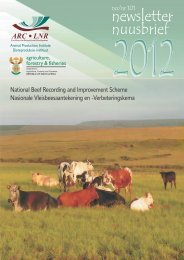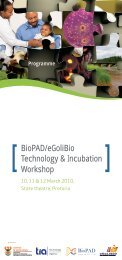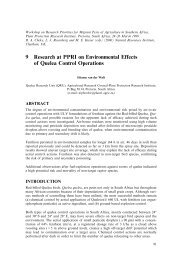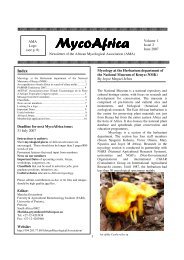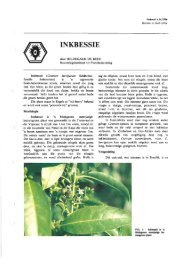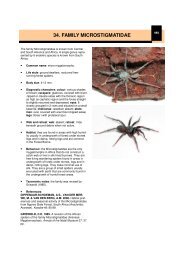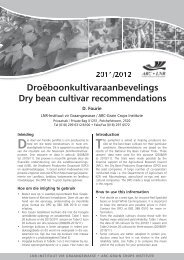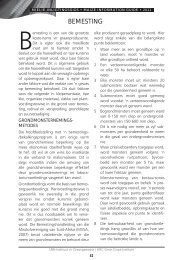Droëboonkultivar aanbevelings Dry bean cultivar recommendations
Droëboonkultivar aanbevelings Dry bean cultivar recommendations
Droëboonkultivar aanbevelings Dry bean cultivar recommendations
Create successful ePaper yourself
Turn your PDF publications into a flip-book with our unique Google optimized e-Paper software.
Inleiding<br />
Dr AJ Liebenberg, Miss HW Heenop† & Mev / Mrs MC Fourie<br />
LNR-Instituut vir Graangewasse / ARC-Grain Crops Institute<br />
Hierdie pamflet is bedoel om produsente te help om<br />
die beste boonkultivars vir hulle toestande te kies.<br />
Die dokument is gebasseer op die resultate van die<br />
nasionale droëboon-kultivarproewe. Drie seisoene (2006<br />
/07 tot 2008/09) se data is gebruik. Die proewe is moont -<br />
lik gemaak deur die finansiële ondersteuning van die<br />
Landbounavorsingsraad (LNR), die Droëboonprodusente<br />
Organi sasie (DPO) en saadmaatskappye. ‘n Groot aantal<br />
medewerkers soos KwaZulu-Natal (KZN) en Mpumalanga<br />
se departemente van landbou, landbou koöperasies en<br />
landbou maatskappye het van die proewe gedoen. Die<br />
DPO het ook ‘n groot bydrae gelewer.<br />
Hoe om die inligting te gebruik<br />
Privaatsak / Private Bag X1251, Potchefstroom, 2520<br />
Tel.: (018) 299 6326 • Faks / Fax: (018) 297 6572<br />
• Besluit eers op ‘n saadtipe byvoorbeeld rooi gespikkelde<br />
bone of kleinwit inmaakbone. Doen dit op grond<br />
van aanvraag, ondervinding en potensiële pryse.<br />
Kontak die DPO by (012) 808 1660 vir meer inligting.<br />
• Kies uit beskikbare kultivars dié met die hoogste<br />
gemiddelde opbrengs en oessekerheid. Tabel 1 bevat<br />
30 kultivars vir die 2008/2009-seisoen en Tabel 2<br />
bevat 23 kultivars oor drie seisoene.<br />
• Sommige kultivars is beter aangepas vir sekere produksiegebiede<br />
maar dit word nie weerspieël in die<br />
oessekerheid nie. Kyk dus hoe die kultivars met<br />
mekaar vergelyk in u produksiegebied (Tabel 3).<br />
• Vergelyk kultivars in Tabelle 1 en 2 met mekaar by<br />
rea listiese opbrengsmikpunte vir u plaas. Hoe nader<br />
Introduction<br />
2009/2010<br />
<strong>Droëboonkultivar</strong> <strong>aanbevelings</strong><br />
<strong>Dry</strong> <strong>bean</strong> <strong>cultivar</strong> <strong>recommendations</strong><br />
This pamphlet is aimed at helping producers select<br />
<strong>bean</strong> <strong>cultivar</strong>s best suited for their particular conditions.<br />
These <strong>recommendations</strong> are based on the<br />
results of the national dry <strong>bean</strong> <strong>cultivar</strong> trials. Three<br />
seasons’ data (2006/07 to 2008/09) were used for this<br />
purpose. The trials were made possible by the financial<br />
support of the Agricultural Research Council (ARC), the<br />
<strong>Dry</strong> Bean Producers Organisation (DPO) and seed companies.<br />
A large number of co-operators conducted trials<br />
i.e. the departments of agriculture of KwaZulu-Natal<br />
(KZN) and Mpumalanga, agricultural co-operatives and<br />
agricultural companies. The DPO also had a large<br />
contribution in this regard.<br />
How to use this information<br />
• First decide on a seed type, for instance red speckled<br />
<strong>bean</strong>s or small white canning <strong>bean</strong>s. It is important to<br />
keep demand and prospective prices in mind. Contact<br />
the DPO at (012) 808 1660 for more information.<br />
• From the available <strong>cultivar</strong>s select those with the<br />
highest mean yield and yield reliability. Table 1 shows<br />
the data of 30 <strong>cultivar</strong>s for the 2008/09 season and<br />
Table 2 shows 23 <strong>cultivar</strong>s for three seasons.<br />
• Some <strong>cultivar</strong>s are better adapted for certain production<br />
areas but this is not reflected in the yield-reliability<br />
table. Use Table 3 to compare the mean yield of the<br />
<strong>cultivar</strong>s for your production area.<br />
• Compare <strong>cultivar</strong>s in Tables 1 and 2 at a realistic yield<br />
LNR-Instituut vir Graangewasse • ARC-Grain Crops Institute
2009/2010<br />
DROËBOONKULTIVARAANBEVELINGS • DRY BEAN CULTIVAR RECOMMENDATIONS<br />
die kultivar se berekende opbrengs aan ‘n bepaalde<br />
mik punt is hoe hoër is die opbrengspotensiaal by<br />
die be trok ke mikpunt. Dit dui op hoër opbrengsstabiliteit.<br />
• Kyk nou na die eienskappe van die kultivar (Tabel 4)<br />
om seker te maak dat dit nie ongewenste eienskappe<br />
het ten opsigte van, byvoorbeeld oopspring, siektevatbaarheid,<br />
groeiseisoenlengte of saadgrootte nie.<br />
• Kultivars verskil min van mekaar in hulle vatbaarheid<br />
vir bakteriese siektes, wortelsiektes en Ascochyta.<br />
Almal is vatbaar behalwe Kranskop-HR 1 wat vetvleksiekte<br />
weer stand het en Teebus-RCR 2 wat<br />
gewone skroei weerstand het. Dit word egter nie in<br />
Tabel 4 aangedui nie.<br />
• Stel vas wat die bemarkingsmoontlikhede van die be-<br />
Tabel 1: Oessekerheid by die verskillende opbrengsmikpunte gdurende 2008/09.<br />
Table 1: Yield reliability at different yield targets during 2008/09.<br />
target for your particular farm. The nearer the calculated<br />
yield of a <strong>cultivar</strong> comes to the yield target, the<br />
higher its yield potential at that particular target. This<br />
indicates higher yield stability.<br />
• Thereafter study the characteristics of the <strong>cultivar</strong> of<br />
your choice (Table 4) to ensure that it has no undesireable<br />
characteristics in terms of shattering, disease<br />
susceptibility, growing season requirements or seed<br />
size.<br />
• Cultivars do not differ much with respect to their<br />
susceptibility to bacterial diseases, root diseases and<br />
Ascochyta (they are all susceptible except Kranskop-HR<br />
1 that has halo blight resistance and Teebus-RCR 2<br />
that has common-blight resistance. This is not<br />
indicated in Table 4.<br />
KULTIVAR OPBRENGSMIKPUNTE / YIELD TARGETS GEM RANG D-PARAM<br />
CULTIVAR MEAN RANK<br />
0.5 1.0 1.5 2.0 2.5 3.0 3.5 4.0<br />
Kleinwit inmaak / Small white canning<br />
1: Teebus 0.05 0.40 0.74 1.08 1.42 1.77 2.11 2.45 1.91 6 0.2497<br />
2: Teebus-RR 1 0.11* 0.62* 1.12* 1.62* 2.12* 2.62* 3.13* 3.63* 2.37 3 0.1607<br />
3: Teebus-RCR 2 0.03 0.57* 1.12* 1.66* 2.21* 2.75* 3.29* 3.84* 2.50 1 0.2094<br />
4: OPS-KW 1 0.00 0.19 0.64 1.09 1.54 1.99 2.44 2.89 2.12 5 0.3762<br />
5: PAN 185 0.24* 0.69* 1.15* 1.60* 2.05 2.51 2.96 3.42 2.36 4 0.1777<br />
6: PAN 123 0.12* 0.62* 1.13* 1.63* 2.14* 2.64* 3.15* 3.65* 2.38 2 0.1609<br />
Rooi gespikkel / Red speckled<br />
7: Kranskop 0.00 0.39 0.90 1.42 1.93 2.45 2.96 3.48 2.04 14 0.0976<br />
8: Kranskop-HR 1 0.00 0.46 0.99 1.52 2.05 2.58* 3.11* 3.65* 2.26 4 0.1496<br />
9: Jenny 0.08 0.54* 1.00 1.46 1.92 2.37 2.83 3.29 2.20 6 0.1649<br />
10: OPS-RS 1 0.00 0.24 0.75 1.26 1.77 2.29 2.80 3.31 2.12 10 0.2240<br />
11: OPS-RS 2 0.03 0.53 1.04 1.54 2.04 2.55 3.05 3.56 2.05 13 0.0553<br />
12: OPS-RS 4 0.30* 0.86* 1.43* 1.99* 2.55* 3.11* 3.68* 4.24* 2.50 1 0.0475<br />
13: RS 5 0.00 0.30 0.81 1.33 1.84 2.35 2.87 3.38 2.15 8 0.2060<br />
14: RS 6 0.00 0.56* 1.14* 1.72* 2.30* 2.87* 3.45* 4.03* 2.32 3 0.0806<br />
15: Sederberg 0.00 0.51 1.05* 1.60* 2.14* 2.69* 3.23* 3.78* 2.33 2 0.1427<br />
16: BONUS 0.00 0.00 0.45 0.94 1.42 1.91 2.39 2.88 1.97 16 0.3665<br />
17: PAN 148 0.00 0.41 0.89 1.37 1.86 2.34 2.82 3.30 2.09 12 0.1484<br />
18: PAN 116 0.00 0.50 1.01 1.52 2.03 2.55 3.06 3.57 2.22 5 0.1320<br />
19: PAN 128 0.00 0.33 0.79 1.26 1.72 2.19 2.65 3.12 2.02 15 0.1801<br />
20: PAN 139 0.09* 0.58* 1.07* 1.55 2.04 2.53 3.01 3.50 2.05 13 0.0538<br />
21: PAN 9249 0.00 0.23 0.78 1.32 1.87 2.41 2.96 3.50 2.10 11 0.1686<br />
22: PAN 9275 0.06 0.52 0.99 1.45 1.91 2.38 2.84 3.30 1.90 19 0.0410<br />
23: PAN 9281 0.04 0.55* 1.06* 1.57* 2.07* 2.58* 3.09 3.60 2.19 7 0.0979<br />
24: PAN 9280 0.15* 0.65* 1.14* 1.63* 2.12* 2.61* 3.10 3.59 2.22 5 0.0853<br />
25: DBS 310 0.17* 0.63* 1.09* 1.55 2.01 2.47 2.93 3.39 1.95 17 0.0296<br />
26: DBS 360 0.00 0.23 0.73 1.22 1.71 2.20 2.69 3.18 2.13 9 0.2710<br />
27: Mkondeni 0.11* 0.55* 0.98 1.42 1.86 2.30 2.74 3.17 1.92 18 0.0594<br />
28: Ukulinga<br />
Carioca<br />
0.00 0.39 0.92 1.45 1.98 2.50 3.03 3.56 2.10 11 0.1088<br />
29: Mkuzi 0.00 0.23 0.81 1.38 1.96 2.54 3.12* 3.69* 2.46 1 0.3794<br />
30: CAR 2008 0.00 0.21 0.76 1.31 1.86 2.41 2.96 3.51 2.31 2 0.3164<br />
Waardes met ’n sterretjie (*) aangedui binne dieselfde kolom is betekenisvol hoër as die gemiddeld<br />
Values indicated with an asterisk (*) in the same column are significantly higher then the mean<br />
LNR-Instituut vir Graangewasse 2<br />
ARC-Grain Crops Institute
2009/2010<br />
DROËBOONKULTIVARAANBEVELINGS • DRY BEAN CULTIVAR RECOMMENDATIONS<br />
paalde kultivar is, byvoorbeeld of die inmaakkwaliteit,<br />
saadgrootte en kleur vir die inmakers of boonhande<br />
laars aanvaarbaar is. Dit bepaal die prys en dus<br />
die winsgewendheid.<br />
• Bestel saad deur u koöperasie, landboumaatskappy,<br />
saadhandelaar of direk van die betrokke saadfirma.<br />
Doen dit een seisoen vooruit om te verseker dat u<br />
saad kry. Waar aangedui word dat dit ‘n nuwe kultivar<br />
is moet in gedagte gehou word dat twee tot drie jaar<br />
nodig is om voldoende gesertifiseerde saad daarvan<br />
te produseer.<br />
• Dring aan op siektevrye, gesertifiseerde saad om die<br />
gevaar van saadgedraagde siektes te beperk (bakteriese<br />
siektes en antraknose). As dit nie beskikbaar is<br />
nie, gebruik ten minste gesertifiseerde saad.<br />
Faktore wat kultivaraanpassing<br />
beïnvloed<br />
• Roes kom meer in KZN en Mpumalanga voor, veral<br />
gedurende nat seisoene en by laat aanplantings. In dié<br />
gebiede moet roesvatbare kultivars dus vermy word.<br />
• Determine the possible market for a specific <strong>cultivar</strong>, for<br />
instance whether the canning quality, seed size or<br />
colour are acceptable to <strong>bean</strong> dealers. This determines<br />
price and therefore the profitability.<br />
• Order seed from your local cooperative, agricultural<br />
company, seed dealer or directly from the seed company.<br />
Do this one season in advance to prevent<br />
disappointment. In the case of a new <strong>cultivar</strong> it must be<br />
borne in mind that at least two years or maybe three<br />
years are needed to produce sufficient amounts of<br />
certified seed.<br />
• Insist on disease free, certified seed to limit the<br />
detrimental effect of seed-borne diseases. If these are<br />
not available you should at least insist on certified<br />
seed.<br />
Factors that determine<br />
adaptation<br />
Tabel 2:Oessekerheid by verskillende opbrengsmikpunte gedurende 2006/07 - 2008/09.<br />
Table 2: Yield reliability at different targets during 2006/07 - 2008/09.<br />
• Rust is more common in KZN and Mpumalanga,<br />
especially in late plantings. Avoid rust-susceptible<br />
<strong>cultivar</strong>s in these areas. The risk can be reduced by<br />
KULTIVAR OPBRENGSMIKPUNTE (t/ha) GEM RANG D-PARAM<br />
CULTIVAR YIELD POTENTIAL MEAN RANK<br />
0.5 1.0 1.5 2.0 2.5 3.0 3.5 4.0<br />
Kleinwit inmaak / Small white canning<br />
Teebus 0.10 0.47 0.85 1.22 1.60 1.97 2.35 2.72 1.55 5 0.1529<br />
Teebus-RR 1 0.10 0.65* 1.19* 1.74* 2.29* 2.83* 3.38* 3.92* 1.85 2 0.0872<br />
Teebus-RCR 2 0.04 0.59 1.14* 1.68* 2.23* 2.78* 3.33* 3.87* 1.87 1 0.1255<br />
OPS KW 1 0.00 0.37 0.87 1.37 1.87 2.37 2.87 3.36 1.72 4 0.2099<br />
PAN 185 0.07 0.60 1.12* 1.64* 2.16* 2.69* 3.21* 3.73* 1.83 3 0.1220<br />
PAN 123 0.05 0.61* 1.16* 1.71* 2.27* 2.82* 3.37* 3.93* 1.85 2 0.1026<br />
Rooi gespikkel / Red speckled<br />
Kranskop 0.08 0.55 1.03 1.50 1.98 2.45 2.93 3.40 1.63 9 0.0778<br />
Kranskop-HR 1 0.13* 0.64* 1.14* 1.64* 2.15* 2.65 3.16 3.66 1.77 3 0.0843<br />
Jenny 0.18* 0.64* 1.10 1.56 2.02 2.48 2.94 3.39 1.72 5 0.0916<br />
OPS-RS 1 0.12* 0.61* 1.10 1.58 2.07 2.55 3.04 3.53 1.74 4 0.0964<br />
OPS-RS 2 0.00 0.48 0.98 1.49 1.99 2.50 3.00 3.51 1.56 10 0.0633<br />
OPS-RS 4 0.24* 0.79* 1.33* 1.88* 2.42* 2.97* 3.51* 4.06* 1.90 1 0.0533<br />
RS 5 0.00 0.37 0.89 1.42 1.95 2.47 3.00 3.53 1.66 8 0.1487<br />
Sederberg 0.03 0.56 1.08 1.61 2.13 2.66 3.18 3.71* 1.77 3 0.1071<br />
Bonus 0.00 0.34 0.76 1.17 1.59 2.01 2.43 2.84 1.55 11 0.1963<br />
PAN 148 0.07 0.55 1.03 1.51 1.99 2.47 2.94 3.42 1.69 7 0.1015<br />
PAN 116 0.10 0.62* 1.15* 1.67* 2.19* 2.72* 3.24* 3.76* 1.80 2 0.0904<br />
PAN 128 0.12* 0.58 1.05 1.52 1.98 2.45 2.92 3.38 1.77 3 0.1394<br />
PAN 139 0.11* 0.59 1.07 1.55 2.03 2.50 2.98 3.46 1.71 6 0.0953<br />
PAN 9249 0.00 0.43 0.98 1.54 2.10 2.65 3.21* 3.76* 1.71 6 0.1219<br />
DBS 310 0.24* 0.68* 1.13* 1.58 2.03 2.48 2.92 3.37 1.74 4 0.0862<br />
DBS 360<br />
Carioca<br />
0.00 0.48 0.98 1.47 1.97 2.46 2.95 3.45 1.71 6 0.1400<br />
Mkuzi 0.00 0.44 1.01 1.58 2.15* 2.72* 3.29* 3.86* 1.90 1 0.2141<br />
Waardes met ‘n sterretjie (*) aangedui binne dieselfde kolom is betekenisvol hoër as die gemiddeld<br />
Values indicated with an asterisk (*) in the same column are significantly higher than the mean<br />
LNR-Instituut vir Graangewasse 3<br />
ARC-Grain Crops Institute
Tabel 3: Gemiddelde saadopbrengs (kg/ha-1) van bone in verskillende produksiegebiede gedurende 2006-2009 en 2008/09.<br />
Table 3: Mean seed yield (kg/ha-1) of <strong>bean</strong>s in different production regions during 2006-2009 and 2008/09.<br />
2009/2010<br />
DROËBOONKULTIVARAANBEVELINGS • DRY BEAN CULTIVAR RECOMMENDATIONS<br />
Kultivars Westelike gebied Mpumalanga Oos-Vrystaat KwaZulu-Natal **Gem. Rangorde Saadfirma<br />
Cultivars Western region Eastern Free State Rank Seed Firm<br />
2006-09 2008/09 2006-09 2008/09 2006-09 2008/09 2006-09 2008/09 2006-09 2008/09 2006-09 2008/09<br />
Klein wit / Small white<br />
Teebus 1851* 2094 1304 1663 1821 2391 1573 1860 1637 2002 6 6 DBS<br />
Teebus-RR 1 1872* 2059 1274 1849 1922 2749 2556 3128 1906 2446 4 4 DBS<br />
Teebus-RCR 2 2161* 2393 1433 1970 1966 3074 2345 2928 1976 2591 3 2 DBS<br />
OPS-KW 1 1836* 1923 1278 2006 1517 1977 2745 3343 1844 2312 5 5 DBS<br />
PAN 185 2163* 2390 1510 2521 1689 2214 2690 3270 2013 2599 1 1 PANNAR<br />
PAN 123 2309* 2336 1323 2102 1894 2764 2471 2798 1999 2500 2 3 PANNAR<br />
Rooi gespikkeld / Red speckled<br />
Kranskop 1959* 2549 1346 1919 1756 2186 2014 2516 1769 2293 12 13 DBS<br />
Kranskop-HR1 2168* 2587 1408 1954 1914 2608 2140 2614 1908 2441 4 4 DBS<br />
Jenny 1961* 2117 1484 2362 1832 2512 2053 2423 1833 2354 8 8 DBS<br />
OPS-RS 1 2309* 2820 1210 1402 1938 2454 2183 2534 1910 2303 3 11 DBS<br />
OPS-RS 2 2125* 2455 1078 1683 1549 2215 2245 2710 1749 2266 13 16 DBS<br />
OPS-RS 4 2399* 2686 1564 2238 1839 2580 2565 3396 2092 2725 1 1 DBS<br />
RS 5 1653* 1819 1162 1784 1644 2201 2625 3334 1771 2285 11 14 DBS<br />
RS 6 2176* 2626 1654* 1955 2376* 2594 2636* 2918 2211* 2523 - 3 IGG/GCI<br />
Sederberg 2064* 2521 1289 1893 1693 2322 2572 3406 1905 2536 5 2 IGG/GCI<br />
Bonus 2131* 2707 1214 1448 1894 2518 1639 1862 1720 2134 14 19 IGG/GCI<br />
PAN 148 1893* 2571 1279 1962 1763 2336 2171 2340 1777 2302 10 12 PANNAR<br />
PAN 116 1887* 2119 1337 2148 1842 2251 2604 3129 1918 2412 2 6 PANNAR<br />
PAN 128 2132* 2448 1201 1362 1823 2270 2356 2668 1878 2187 7 18 PANNAR<br />
PAN 139 1728* 1996 1251 1654 1847 2188 2346 2922 1518 2190 15 17 PANNAR<br />
PAN 9249 1947* 2161 1069 1529 1659 2067 2600 3310 1819 2267 9 15 PANNAR<br />
PAN 9275 - 1877 - 1638 - 1999 - 2688 - 2051 - 21 PANNAR<br />
PAN 9281 - 2179 - 2084 - 2319 - 2934 - 2379 - 7 PANNAR<br />
PAN 9280 - 2422 - 2036 - 2305 - 2955 - 2430 - 5 PANNAR<br />
DBS 310 2231* 2331 1358 1574 1806 2141 2207 2462 1901 2127 6 20 DBS<br />
DBS 360 2244* 2674 1382 1940 1873 2533 2132 2238 1908 2346 4 9 DBS<br />
Mkondeni 1743* 1880 1273* 1609 1918* 2171 2108* 2410 1761* 2018 - 22 PRO-SEED<br />
Ukulinga 2039* 2253 1576* 1953 2000* 2150 2570* 2902 2046* 2315 - 10 PRO-SEED<br />
Carioca<br />
Mkuzi 2104* 2057 1431 2135 1758 2282 2881 4139 2044 2653 2 1 PANNAR<br />
CAR 2008 - 1826 - 1921 - 2226 - 3817 - 2448 1 2 IGG/GCI<br />
LNR-Instituut vir Graangewasse 4<br />
ARC-Grain Crops Institute<br />
- Geen waardes is beskikbaar nie / No values are available ** Gemiddelde van alle proewe in Suid-Afrika / Mean of all trials in South Africa * Gemiddeld oor 2 jare / Mean over 2 years
2009/2010<br />
DROËBOONKULTIVARAANBEVELINGS • DRY BEAN CULTIVAR RECOMMENDATIONS<br />
Die risiko kan verminder word deur so vroeg moontlik<br />
te plant en/of goeie chemiese beheer toe te pas.<br />
• In Tabel 4 word die invloed van swamdoders op die<br />
gemiddelde opbrengs van verskillende kultivars oor<br />
drie seisoene op bespuite en onbespuite proewe op<br />
Cedara, Greytown en Kokstad aangetoon. Die persentasie<br />
dui die grootste moontlike opbrengs verhoging<br />
aan wat ‘n produsent kan verwag as gevolg van die<br />
beheer van swamsiektes. In die geval van kultivars met<br />
roesweerstand was die opbrengs verhogings die gevolg<br />
van die beheer van ander swamsiektes, byvoorbeeld<br />
Ascochyta en hoekige blaarvlek (HBV). Let asseblief<br />
daarop dat die resultate van sommige kultivars<br />
baie tussen seisoene gewissel het en groot afwykings<br />
van die gemiddeldes wat hier gegee word, kom dus<br />
voor. Hierdie syfers moet slegs beskou word as aanduidings<br />
van wat kan gebeur as toestande gunstig is<br />
vir die ontwikkeling van swam siektes. Hoe verder wes<br />
die kultivars geplant word, hoe kleiner sal die effek van<br />
swambeheer wees.<br />
• Alle kleinsadige kultivars het weerstand teen HBV. Die<br />
meeste grootsadige kultivars is vatbaar maar die<br />
afgelope seisoen is 10 met weerstand ingesluit. Hulle<br />
is PAN 116, Sederberg, PAN 9249, PAN 9275, PAN<br />
9280, PAN 9281, PAN 139, Mkondeni, Ukulinga en<br />
OPS-RS 4.<br />
• Besmetting met bakteriese siektes, veral vetvlek en<br />
bakteriese bruinvlek is meer algemeen wes van die<br />
Drakensberge as in KZN.<br />
• Kultivars met ‘n kort groeiseisoen en ‘n bepaalde groeiwyse<br />
het oor die algemeen ‘n laer opbrengs potensiaal<br />
(veral in gebiede met koue nagte) maar is beter<br />
aangepas by hoër nagtemperature.<br />
• Kies ‘n kultivar wat inpas in die lengte van die beskikbare<br />
groeiseisoen. Oor die algemeen kan sewe dae<br />
afgetrek word van die groeiseisoenlengte wat in Tabel<br />
4 aangegee word omdat die bone dan reeds fisio logies<br />
volwasse is en nie meer deur ryp beskadig sal<br />
word nie. Hoë of lae temperature sal die groeiseisoen<br />
verkort of verleng en die syfers in Tabel 4 moet dus nie<br />
as absoluut beskou word nie. Kultivars kan gemiddeld<br />
10 dae vroeër as normaal ryp word weens warm, droë<br />
toestande voor oestyd. In koel, nat toestande kan hulle<br />
10 tot 20 dae later as normaal ryp word.<br />
• Vermy groot aanplantings van kultivars wat geneig is<br />
tot oopspring. Oes sulke kultivars so gou moontlik<br />
nadat hulle oesryp is. Al die kultivars wat hier bespreek<br />
word, het goeie oopspringweerstand.<br />
Kleinwit inmaakbone<br />
Daar is ‘n goeie mark vir inmaakbone. Slegs kultivars wat<br />
deur die inmakers aanvaar word, behoort aangeplant te<br />
word aangesien die mark vir kleinwit verpakkingsbone<br />
beperk is.<br />
• Teebus (roesvatbaar) het die beste inmaakkwaliteit en<br />
behaal die hoogste pryse as keurgraadbone. Teebus se<br />
gemiddelde opbrengs is laer as die ander klein wit<br />
kultivars. Dit is egter goed aangepas vir Noordwes<br />
Provinsie en die Oos-Vrystaat.<br />
• Teebus-RR 1 het die tweede hoogste gemiddelde<br />
planting as early as possible and/or by application of<br />
effective chemical control.<br />
• In Table 4 the effect of fungicides on the yield of<br />
different <strong>cultivar</strong>s on sprayed and unsprayed trials is<br />
compared for three seasons at Cedara, Greytown and<br />
Kokstad. The percentages indicate the largest yield<br />
increase that a producer can expect as a result of<br />
control of fungus diseases. In the case of rust-resistant<br />
<strong>cultivar</strong>s control of other fungus diseases e.g.<br />
Ascochyta and angular leaf spot (ALS) contributes to<br />
yield increase. Please note that results varied greatly<br />
between seasons for some <strong>cultivar</strong>s. This data must<br />
therefore only be considered as indications of what<br />
could happen when conditions are favourable for the<br />
de velopment of fungus diseases. The effect of fungicide<br />
application will be less pronounced in productions<br />
further to the west.<br />
• All small-seeded <strong>cultivar</strong>s are resistant to ALS. Most<br />
large-seeded <strong>cultivar</strong>s are susceptible but 10 with<br />
resistance were included in the past season’s trials,<br />
i.e. PAN 116, Sederberg, PAN 9249, PAN 9275, PAN<br />
9280, PAN 9281, PAN 139, Mkondeni, Ukulinga and<br />
OPS-RS 4.<br />
• Bacterium diseases, especially halo blight and bacterial<br />
brown spot are more common west of the<br />
Drakensberg than in KZN.<br />
• Cultivars with a short growing season, as well as a<br />
determinate growth habit generally have a lower<br />
yield potential (especially in areas with cool nights)<br />
than those with a long growing season. However,<br />
they are better adapted to higher night temperatures.<br />
• Select a <strong>cultivar</strong> that fits into the length of the<br />
growing season. Generally seven days could be<br />
deducted from the length of the growing season<br />
indicated in Table 4 as the <strong>bean</strong>s are already physiologically<br />
mature at this stage and will not be<br />
damaged by frost. High or low temperatures will<br />
shorten or lengthen the growing season and the<br />
figures in Table 4 must therefore not be regarded<br />
absolute. Under hot, dry conditions before harvesting<br />
time <strong>bean</strong>s may ripen on average 10 days earlier than<br />
usual. Under cool, wet conditions <strong>bean</strong>s may ripen<br />
10 to 20 days later than usual.<br />
• Avoid planting large areas with <strong>cultivar</strong>s that are<br />
prone to shattering. Harvest such <strong>cultivar</strong>s as soon as<br />
possible after maturity. All the <strong>cultivar</strong>s depicted here<br />
have good resistance to shattering.<br />
Small white canning <strong>bean</strong>s<br />
There is a good market for canning <strong>bean</strong>s. Only <strong>cultivar</strong>s<br />
that are acceptable to the canners should be grown as<br />
the market for pre-packed, small-white <strong>bean</strong>s is limited.<br />
• Teebus (susceptible to rust) has the best canning quality<br />
and reaches the highest price by producing<br />
choice-grade <strong>bean</strong>s. The mean yield of Teebus is<br />
lower than that of the other small-white entries, but,<br />
it is well adapted in North-West Province and the<br />
eastern Free State.<br />
LNR-Instituut vir Graangewasse 5<br />
ARC-Grain Crops Institute
2009/2010<br />
DROËBOONKULTIVARAANBEVELINGS • DRY BEAN CULTIVAR RECOMMENDATIONS<br />
Tabel 4: Algemene inligting oor droëboonkultivars gedurende 2006/07-2008/09 en 2008/09.<br />
Table 4: General information on dry <strong>bean</strong> <strong>cultivar</strong>s during 200/076-2008/09 and 2008/09.<br />
Kultivars Saad beskikbaar Groeiwyse Groeiseisoen Sade per Omval Oopspring Siektes Opbrengsverhoging (%)<br />
(dae) 100g agv swamdoder<br />
Cultivars Seed available Growth habit Growing season Seeds per Lodging Shattering Diseases Yield increase (%) as a<br />
(days) 100g result of fungicidesa<br />
HBV/ALS Roes/Rust BCMV 2005-08 2007/08<br />
Klein wit / Small white<br />
Teebus Ja/Yes I 104 425 B B B V B 17 18<br />
Teebus-RR 1 Ja/Yes I 108 413 B B B B B 5 17<br />
Teebus–RCR 2 Ja/Yes I 112 496 B B B B B 31 19<br />
OPS-KW 1 Nee/No II 118 551 B B B B B 10 8<br />
PAN 185 Ja/Yes II 114 643 B B B B B 9 9<br />
PAN 123 Nee/No I 114 489 B B B B B 17 19<br />
Rooi gespikkel / Red speckled<br />
Kranskop Ja/Yes II 114 230 MV B V MB B 9 19<br />
Kranskop-HR 1 Ja/Yes II 115 253 MV B MV MB B 20 29<br />
Jenny Ja/Yes II 115 209 MV B V MB B 33 42<br />
OPS-RS 1 Nee/No II 113 223 MV B V MB B 2 31<br />
OPS-RS 2 Ja/Yes I 118 213 B B V MB B 16 32<br />
OPS-RS 4 Ja/Yes II 113 246 MV B MB MB B 8 18<br />
RS 5 Ja/Yes I 114 226 B B V MB V 13 20<br />
RS 6 Nee/No II 116* 222* MV B V MB B 33* 42<br />
Sederberg Nee/No II 115 221 MV B B B B 10 2<br />
Bonus Nee/No III 114 248 MV B V V V 27 44<br />
PAN 148 Ja/Yes II 115 267 MV B V MB B 32 56<br />
PAN 116 Ja/Yes II 113 221 B B B B B 6 8<br />
PAN 128 Ja/Yes II 112 240 MV B V MB B 19 59<br />
PAN 139 Ja/Yes II 113 237 MB B B B B 7 22<br />
PAN 9249 Ja/Yes II 114 197 MB B B B B 5 10<br />
PAN 9275 Nee/No II 119** 188** MB B B B B - 19<br />
PAN 9281 Nee/No II 112** 223** MB B B MB B - 22<br />
PAN 9280 Nee/No II 118** 203** MB B B MB B - 18<br />
DBS 310 Ja/Yes II 112 257 MV B V MB B 23 33<br />
DBS 360 Ja/Yes II 115 263 MV B V MB B 25 68<br />
Mkondeni Ja/Yes II 117* 210* MB B B MV B 7* 17<br />
Ukulinga Ja/Yes I 121* 200* B B B MB B 18* 23<br />
Carioca<br />
Mkuzi Nee/No II 110 512 MB B B B B -3 10<br />
CAR 2008 Nee/No II 114** 429** MB B B B B - -4<br />
LNR-Instituut vir Graangewasse 6<br />
ARC-Grain Crops Institute<br />
* Gemiddeld oor 2 jaar / Mean over<br />
2 years<br />
** Een jaar / One year<br />
- Geen inligting is beskikbaar nie / No<br />
data are available<br />
a Cedara & Greytown<br />
chemical contol usually needed<br />
MB Matige weerstand / Moderately resistant: chemise<br />
beheer nie nodig nie / no chemical control needed<br />
B Goeie weerstand / Good resistance: geen chemiese<br />
beheer nodig / no chemical control needed<br />
BCMV Boontjie Mosaiek-virus / Bean Common Mosaic Virus<br />
HBV / ALS Hoekige blaarvlek / Angular leaf spot<br />
Tipe/Type I Bepaalde groeiwyse: Blomme aan punt van takke beeïndig stamverlenging /<br />
Determinate growth habit: Flowers at end of branches arrest stem growth<br />
Tipe/Type II Onbepaalde groeiwyse: Min kort en regopgroeiende sytakke, groei nog na blom /<br />
Indeterminate growth habit: Few short and upright branches, grow after flowering<br />
Tipe/Type III Onbepaalde groeiwyse: Baie lang en plat rankende sytakke / Indeterminate growth<br />
habit: Very long and low trailing branches<br />
V Vatbaar / Susceptible: chemiese beheer noodsaaklik / chemical control necessary<br />
MV Matig vatbaar / Moderately susceptible: chemiese beheer gewoonlik nodig /
2009/2010<br />
DROËBOONKULTIVARAANBEVELINGS • DRY BEAN CULTIVAR RECOMMENDATIONS<br />
opbrengs oor drie seisoene. Dit kom baie ooreen met<br />
Teebus maar het goeie roesweerstand en is wyd aangepas.<br />
Sy inmaakkwaliteit is goed en is aanvaarbaar vir<br />
die inmakers. Saad is hierdie seisoen beskikbaar.<br />
• PAN 185 en OPS-KW 1 se inmaakkwaliteit is nie aanvaarbaar<br />
vir die inmakers nie en produsente moet<br />
seker maak van ‘n mark voordat een van hierdie kultivars<br />
aangeplant word. Beide het ‘n hoë gemiddelde<br />
opbrengs en oessekerheid en is wyd aangepas. Saad<br />
van PAN 185 is beskikbaar.<br />
• Teebus-RCR 2 is ‘n nuwe kultivar. Dit het die hoogste<br />
gemiddelde opbrengs oor drie seisoene gehad. Dit<br />
stem in baie opsigte ooreen met Teebus behalwe dat<br />
dit weerstand teen roes en gewone skroei het. Dit<br />
ondergaan egter nog fabriekstoetse.<br />
• PAN 123 het die tweede hoogste gemiddelde opbrengs<br />
oor drie seisoene gehad en het goeie roesweer -<br />
stand. Die resultate van die fabriekstoetse moet bekend<br />
wees voordat dit vir inmaakdoeleindes aanbeveel kan<br />
word.<br />
Rooi gespikkelde bone<br />
Rooi gespikkelde bone het ‘n groot aanvraag en goeie<br />
pryse word behaal, maar die mark kan diskrimineer<br />
teen kultivars met klein sade of ‘n donker agtergrond-<br />
kleur.<br />
• Kultivars waarvan daar saad beskikbaar is. Langseisoen<br />
kultivars met hoë gemiddelde opbrengs en oessekerheid,<br />
sowel as goeie saadkwaliteit en siekteweerstand is<br />
OPS-RS 4, PAN 116, Kranskop-HR 1, PAN 128, DBS<br />
310, Jenny, PAN 9249, DBS 360, PAN 139, PAN 148,<br />
RS 5, Kranskop, OPS-RS 2, Ukulinga en Mkondeni.<br />
Opbrengs verskille binne die groep kan so hoog as 0.34<br />
t ha -1 wees. DBS 360 en PAN 148 het die kleinste sade<br />
in hierdie groep en PAN 9249 en Jenny die grootste.<br />
PAN 116, OPS-RS 2 en RS 5 het ‘n baie goeie staanvermoë.<br />
Die kultivars PAN 135, PAN 118 en Gadra was<br />
nie in die proewe ingesluit nie maar klein hoeveel hede<br />
saad is daarvan beskikbaar.<br />
• Kultivars waarvan daar nie hierdie seisoen saad beskikbaar<br />
is nie. OPS-RS 1, Sederberg en die nuwer kultivars<br />
RS 6, PAN 9275, PAN 9280 en PAN 9281. Bonus is baie<br />
vatbaar vir roes en het ‘n laer opbrengs potensiaal as<br />
meeste van die langseisoen kultivars. Dit word as<br />
kontrole ingesluit.<br />
Carioca bone<br />
Die mark vir Carioca bone is baie beperk en produsente<br />
moet seker maak van ‘n afset alvorens hulle dit plant.<br />
• Mkuzi het ‘n besondere hoë opbrengsvermoë en oessekerheid,<br />
is wyd aangepas en het goeie weerstand<br />
teen feitlik alle boonsiektes. Hierdie kultivar word veral<br />
vir KZN aanbeveel vanweë sy siekteweerstand. Daar is<br />
egter nie saad beskikbaar nie.<br />
• CAR 2008 is ‘n nuwe kultivar met ‘n laer opbrengs as<br />
Mkuzi. Dit het groter sade met ‘n ligter agtergrondkleur.<br />
Dit het weerstand teen oopspring, roes, HBV en<br />
BCMV.<br />
• Teebus-RR 1 produced the second highest mean<br />
yield over three seasons. It is very similar to Teebus<br />
except that it is resistant to rust and is widely<br />
adapted. It has good canning quality that is<br />
acceptable to canners. Seed is available for this<br />
season.<br />
• The canning quality of PAN 185 and OPS-KW 1 is not<br />
acceptable to canners and producers must secure a<br />
market before planting one of these <strong>cultivar</strong>s. Both<br />
have a high mean yield as well as yield reliability and<br />
are widely adapted. Seed of PAN 185 is available.<br />
• Teebus-RCR 2 had the highest mean yield over three<br />
seasons. It is similar to Teebus in many respects<br />
except that it is resistant to rust and common blight.<br />
It is still undergoing factory canning tests.<br />
• PAN 123 had the second highest mean yield over<br />
three seasons and has good disease resistance.<br />
Results of factory canning tests must, however, be<br />
available before it can be recommended for canning<br />
purposes.<br />
Red speckled <strong>bean</strong>s<br />
There is a good market for red-speckled <strong>bean</strong>s and high<br />
prices can be obtained. However, the market might discriminate<br />
against <strong>cultivar</strong>s with small seeds or a dark<br />
background colour.<br />
• Cultivars of which seed is available. Long-season <strong>cultivar</strong>s<br />
with high mean yields and yield reliability as well<br />
as acceptable seed quality and disease resistance are<br />
OPS-RS 4, PAN 116, Kranskop-HR 1, PAN 128, DBS<br />
310, Jenny, PAN 9249, DBS 360, PAN 139, PAN 148,<br />
RS 5, Kranskop, OPS-RS 2, Ukulinga and Mkondeni.<br />
Yield differences in this group can be as high as 0.34 t<br />
ha -1. In this group DBS 360 and PAN 148 have the<br />
smallest seeds and PAN 9249 and Jenny the largest.<br />
PAN 116, OPS RS 2 and RS 5 have excellent lodging<br />
resistance. PAN 135, PAN 118 and Gadra were not included<br />
in this season’s trials but small quantities of<br />
seed are available.<br />
• Cultivars of which no seed is available are OPS-RS 1,<br />
Sederberg and the newer <strong>cultivar</strong>s i.e. RS 6, PAN 9275,<br />
PAN 9280 and PAN 9281. Bonus is highly suscept -<br />
ible to rust and has a lower yield potential than most<br />
of the long-season <strong>cultivar</strong>s. It was included as a<br />
control.<br />
Carioca <strong>bean</strong>s<br />
The market for Carioca <strong>bean</strong>s is very limited and producers<br />
must ascertain the availability of a market before<br />
growing these <strong>cultivar</strong>s.<br />
• Mkuzi had decidedly high yields and yield reliability, is<br />
widely adapted and has high levels of resistance to<br />
almost all <strong>bean</strong> diseases. This <strong>cultivar</strong> is recommended<br />
for KZN because of its disease resistance. However,<br />
there will be no seed available.<br />
• Car 2008 is a new <strong>cultivar</strong> with a lower yield than<br />
Mkuzi. It has larger seeds with a lighter background<br />
colour. It is resistant to shattering, rust, ALS and BCM.<br />
LNR-Instituut vir Graangewasse 7<br />
ARC-Grain Crops Institute
Ander saadtipes<br />
Lappiesbone (kultivar Maskam) word hoofsaaklik in die<br />
Wes-Kaap onder besproeiing verbou vanweë sy siektevatbaarheid<br />
en kwaliteitsvereistes. Die mark hiervoor is<br />
baie beperk.<br />
Grootwit nierbone<br />
Daar is ‘n beperkte plaaslike mark vir groot wit nierbone.<br />
Dit behaal hoë pryse gedurende seisoene wanneer daar<br />
nie oorproduksie is nie.<br />
• SSN 1 (nie in proewe) is die enigste kultivar in hierdie<br />
saadtipe. Bye is nodig vir bestuiwing. Nierbone is baie<br />
gevoelig vir hoë temperature gedurende die blomperiode<br />
en dit word daarom slegs aanbeveel vir koel,<br />
hoë-reënvalgebiede waar dit hoë opbrengste gee.<br />
Weens sy hoë siekteweerstand is nierbone in hierdie<br />
gebiede beter aangepas as byvoorbeeld rooi gespikkelde<br />
bone. Geen gesertifiseerde saad is beskikbaar<br />
nie. Die mark vir nierbone is baie beperk.<br />
Verdere inligting<br />
‘n Nuttige bron van verdere inligting is die Droëbone<br />
Produksiehandleiding wat op bestelling verkrygbaar is<br />
vanaf die DPO of LNR-IGG.<br />
Hierdie publikasie is ook beskikbaar op<br />
http://www.arc.agric.za/home.asp?pid=370&toolid=63<br />
&sec=1231<br />
Saad kan by saadhandelaars of direk by die leweransiers<br />
bestel word. Indien u probleme ondervind met u bestelling<br />
kontak die volgende:<br />
<strong>Dry</strong> Bean Seed (Pty) Ltd., Posbus 15587, Lynn East, 0039.<br />
Tel. (012)808 1660, Faks (012) 808 1662<br />
PANNAR, Posbus 19, Greytown, 3250. Tel. (033) 413<br />
9500, Faks. (033) 413 2618.<br />
McDonald Seeds, Posbus 40, Mkondeni, 3212. Faks. 033<br />
346 0121.<br />
2009/2010<br />
DROËBOONKULTIVARAANBEVELINGS • DRY BEAN CULTIVAR RECOMMENDATIONS<br />
8<br />
Other seed types<br />
Painted Lady (<strong>cultivar</strong> Maskam) is mainly produced in the<br />
Western Cape under irrigation because of its disease<br />
susceptibility and quality requirements. Its market is very<br />
limited.<br />
Large white kidney <strong>bean</strong>s<br />
There is a limited local market for large white kidney<br />
<strong>bean</strong>s. They reach high prices in seasons when overproduction<br />
does not occur.<br />
• SSN 1 (not included in the trials) is the only <strong>cultivar</strong><br />
available in this seed type. Kidney <strong>bean</strong>s are very<br />
sensitive to high temperatures during the flowering<br />
period. Bees are necessary for pollination. They are<br />
only recommended for the cool, high-rainfall areas<br />
where high yields can be obtained. Because of their<br />
disease resistance, kidney <strong>bean</strong>s are better adapted in<br />
these areas than for instance red-speckled <strong>bean</strong>s. No<br />
certified seed is available.<br />
Further information<br />
A useful source of information is the <strong>Dry</strong> Bean Production<br />
Manual that could be ordered from the DPO or ARC-<br />
GCI.<br />
This publication is also available on<br />
http://www.arc.agric.za/home.asp?pid=370&toolid=63&<br />
sec=1231<br />
Seed can be ordered from seed dealers or directly from the<br />
suppliers. Should you encounter problems with your order<br />
please contact the following organisations:<br />
<strong>Dry</strong> Bean Seed (Pty) Ltd, P.O. Box 15587, Lynn East, 0039.<br />
Tel. (012) 808 1660. Fax. (012) 808 1662<br />
PANNAR, P.O. Box 19, Greytown, 3250. Tel. (033) 413<br />
9500. Fax. (033) 413 2618.<br />
McDonald Seeds, P.O. Box 40, Mkondeni, 3212. Fax 033<br />
346 0121.
2006/07-2008/09<br />
Verslag oor die droëbone<br />
strookproewe<br />
Report on the dry <strong>bean</strong> strip trials<br />
Inleiding / Introduction<br />
Sedert die 2006/07 seisoen was droëbone strookproewe<br />
beplan en uitgevoer as ‘n gesamentlike projek<br />
tussen die Droëbone Produsente Orga ni sasie<br />
(DPO), die saad maat skappy PANNAR en die LNR-Instituut<br />
vir Graan ge wasse (LNR-IGG) met die volgende doelwitte:<br />
a) Evaluering van die verskillende kommersieël beskikbare<br />
droëboonkultivars op ‘n skaal wat produsente in staat<br />
sal stel om dit te vergelyk met hulle eie toestande.<br />
b) Vergelyking van die aanpassing en opbrengspotensiaal<br />
van kultivars op ’n groter skaal as in die nasionale droëbone<br />
kultivarproewe (kultivarproewe).<br />
c) Evaluering van akkerboukundige eienskap pe soos<br />
weerstand teen omval, oopspring en geskiktheid vir<br />
meganiese oes.<br />
d) Gebruik deur saadmaatskappye vir be markingsdoeleindes<br />
tydens inligtingsdae en besoeke deur produsente<br />
en verteenwoordigers.<br />
Metodes / Methods<br />
AJ Liebenberg & D Fourie<br />
LNR-Instituut vir Graangewasse / ARC-Grain Crops Institute<br />
One 25kg bag of certified seed per <strong>cultivar</strong> was supplied<br />
for each trial and planted under the production practices<br />
of the producer in strips of three, four or eight rows.<br />
Each trial consisted of 12 red speckled <strong>cultivar</strong>s, with a<br />
control strip at the start and finish, as well as after every<br />
four <strong>cultivar</strong>s. Only one <strong>cultivar</strong> was used as control<br />
within each trial, but different controls were used in the<br />
different production regions (see Tables 1 - 4). The trials<br />
were planted and harvested at the same time as the<br />
commercial <strong>bean</strong>s and a representative of a seed company<br />
supervised both activities. During the growing<br />
season producers and representatives visited the trials.<br />
Information days were held at some of the trials.<br />
Die proefresultate is statisties ontleed en die opbrengs is<br />
be reken. Die opbrengs (t ha-1 ) en die opbrengs as<br />
persentasie van die kontrole asook hulle rangordes is<br />
bereken vir elke proef en produksiegebied. Die variasie<br />
tussen die kontrole stroke is gebruik om die uniformiteit<br />
(koëfisient van variasie (CV)) van ‘n proef te bereken.<br />
Wanneer die CV te hoog was is die resultate as onbetroubaar<br />
beskou en is nie gebruik in die berekening<br />
van die gemiddeldes van ‘n produksiegebied nie. Vir elke<br />
gebied is die gemiddelde opbrengs van die kultivars ook<br />
vergelyk met dié in die kultivarproewe. Wan neer die<br />
rangordes van ‘n kultivar in die twee stelle proewe met<br />
drie of minder verskil het is dit beskou as ‘n goeie ooreenkoms.<br />
Resultate / Results<br />
Yields of the different sites varied mainly as a result of the<br />
difference in rainfall/irrigation and soil type. The yields are<br />
expressed in t ha -1 and as a percentage of the control. The<br />
ranks of the yield in t ha -1 and percentage of the control<br />
differed slightly in a few instances.<br />
Oos Vrystaat / Eastern Free State<br />
(Tabel / Table 1)<br />
a) Die gemiddelde opbrengs van die strookproewe (1.88<br />
t ha-1 ) was laer as dié van die kultivarproewe (2.30 t<br />
ha-1 ).<br />
b) Vier kultivars het hoër opbrengste in die strookproewe<br />
gehad: PAN 116, PAN 139, PAN 9249 en DBS 310.<br />
c) Die helfte van die kultivars het goeie ooreenkomste<br />
tussen die twee stelle proewe getoon: OPS-RS 4 (hoog)<br />
PAN 128, PAN 148, RS 5, Kranskop en OPS-RS 2.<br />
Mpumalanga (Tabel / Table 2)<br />
Wanneer die gemiddelde opbrengs van die strook- en<br />
kultivar proewe vergelyk word sien ons die volgende verskille<br />
en ooreenkomste.<br />
a) Die gemiddelde opbrengs van die strookproewe (2.94<br />
t ha-1 ) was hoër as dié van die kultivarproewe (1.81 t<br />
ha-1 ).<br />
b) OPS-RS 2 het beter gepresteer in die strookproewe<br />
terwyl DBS 310 en PAN 139 beter presteer het in die<br />
kultivar proewe.<br />
c) Die meerderheid van die kultivars (9) se opbrengs het<br />
rede like ooreenkomte in rangorde getoon tussen die<br />
twee stelle proewe behalwe PAN 128, DBS 310 en DBS<br />
360.<br />
North West (Table 3)<br />
Comparing the means of the strip and <strong>cultivar</strong> trials we<br />
observe the following:<br />
a) The mean yield of the strip trials (2.75 t ha -1 ) was<br />
higher than that of the <strong>cultivar</strong> trials (2.37 t ha -1 ).<br />
b) The following <strong>cultivar</strong>s had higher yields in the strip<br />
trials: PAN 128, DBS 310 and PAN 116.<br />
c) Seven <strong>cultivar</strong>s showed similarity in rank between the<br />
two sets of trials: DBS 360, OPS-RS 4, Kranskop-HR 1,<br />
Kranskop, PAN 139, PAN 9249 and RS 5.<br />
LNR-Instituut vir Graangewasse 9<br />
ARC-Grain Crops Institute
2007/08-2008/09<br />
VERSLAG OOR DIE DROËBONE STROOKPROEWE • REPORT ON THE DRY BEAN STRIP TRIALS<br />
KwaZulu-Natal (Tabel / Table 4)<br />
Trials were planted at two localities i.e. Vryheid (irrigation)<br />
and Greytown (rain fed) but the trial at Vryheid was damaged<br />
by wind during the harvesting process and the results of the<br />
remaining trial are given in Table 4.<br />
Comparing the mean yields of the strip and the <strong>cultivar</strong> trials<br />
we see that:<br />
a) The mean of the <strong>cultivar</strong> trials (2.81 t ha -1) was higher<br />
than that of the Greytown trial (2.09 t ha -1).<br />
b) The following <strong>cultivar</strong>s ranked higher in the strip trials:<br />
PAN 148, DBS 360, Kranskop and DBS 310.<br />
c) There was similarity between the ranks in the strip- and<br />
<strong>cultivar</strong> trials in the case of for the following four <strong>cultivar</strong>s:<br />
OPS-RS 4, RS 5, PAN 139 and PAN 128.<br />
Limpopo (Tabel / Table 4)<br />
One trial was planted under irrigation at Bela-Bela. Com paring<br />
the yields of the strip and <strong>cultivar</strong> trials we observe the<br />
following.<br />
a) The mean of the strip trial (3.04 t ha -1) was much higher<br />
than that of the <strong>cultivar</strong> trial (1.85 t ha -1).<br />
b) The following two <strong>cultivar</strong>s ranked higher in the strip trial:<br />
OPS-RS 4 and Kranskop-HR 1.<br />
c) PAN 116 and PAN 9249 ranked higher in the <strong>cultivar</strong> trial.<br />
d) There was considerable similarity in the ranking of the<br />
other eight <strong>cultivar</strong>s.<br />
Table 1. Yield of dry <strong>bean</strong> <strong>cultivar</strong>s in the strip trials in the eastern Free State 2008/2009 with PAN 148 as the control.<br />
Cultivar D Viljoen B van Zyl EM Scheepers Mean yield Mean yield of<br />
Clarens Bethlehem Fouriesburg of strip trials <strong>cultivar</strong> trials<br />
Nr Name t ha-1 % Control t ha-1 % Control t ha-1 % Control t ha-1 Rank % Control Rank t ha-1 Rank<br />
1 PAN 148 2.88 120 1.90 81 1.36 99 2.05 5 100 5 2.34 4<br />
2 PAN 128 2.85 119 1.88 81 1.41 102 2.05 5 101 4 2.27 5<br />
3 PAN 116 3.27 136 2.17 93 1.59 116 2.34 1 115 1 2.25 6<br />
4 PAN 139 3.18 132 2.17 93 1.21 88 2.19 3 104 3 2.19 9<br />
5 RS 5 1.41 59 1.16 50 1.76 128 1.44 10 79 10 2.20 8<br />
6 PAN 9249 2.17 90 2.06 88 1.26 92 1.83 6 90 6 2.07 11<br />
7 Kranskop 1.05 44 2.39 103 1.37 99 1.60 8 82 9 2.19 9<br />
8 OPS-RS 4 2.85 118 2.27 98 1.63 119 2.25 2 112 2 2.58 2<br />
9 OPS-RS 2 1.47 61 1.68 72 0.95 69 1.37 11 67 11 2.22 7<br />
10 DBS 360 1.33 55 2.26 97 1.46 106 1.68 7 86 7 2.53 3<br />
11 DBS 310 3.17 132 1.94 83 1.34 98 2.15 4 104 3 2.14 10<br />
12 Kranskop-HR 1 1.16 48 1.86 80 1.66 120 1.56 9 83 8 2.61 1<br />
13 Jenny - - - - - - - - - -<br />
Trial Mean 2.23 1.98 1.42 1.88 2.30<br />
Mean of control 2.41 2.33 1.38 2.04<br />
CV (%) 15.55 8.11 16.27<br />
Planting date 03/12/08 03/12/08 01/12/08<br />
Harvest date 04/06/09 27/04/09 31/03/09<br />
Table 2. Yield of dry <strong>bean</strong> <strong>cultivar</strong>s in the strip trials in Mpumalanga 2008/2009 with Kranskop as the control.<br />
Cultivar PP Mare R van Eden G Anderson L Schmidt F Potgieter Mean yield of Mean yield<br />
Delmas Middelburg Middelburg Groblersdal Heidelberg strip trials <strong>cultivar</strong><br />
of trials<br />
% % % % % %<br />
Nr Name t ha-1 Control t ha-1 Control t ha-1 Control t ha-1 Control t ha-1 Control t ha-1 Rank Control Rank t ha-1 Rank<br />
1 PAN 148 2.92 166 3.30 102 3.00 84 3.49 113 3.06 135 3.15 3 120 3 1.96 3<br />
2 PAN 128 2.79 159 2.44 76 3.91 110 3.33 108 2.09 92 2.91 5 109 7 1.36 12<br />
3 PAN 116 2.72 155 3.05 94 4.29 120 3.35 109 2.96 131 3.27 2 122 1 2.15 2<br />
4 PAN 139 1.91 109 1.67 52 3.80 107 2.29 74 1.95 86 2.32 12 86 11 1.65 9<br />
5 RS 5 2.25 127 1.86 58 3.96 111 3.23 105 2.43 107 2.75 10 102 8 1.78 7<br />
6 PAN 9249 1.59 90 2.02 63 3.11 87 3.25 106 2.09 92 2.41 11 88 10 1.53 11<br />
7 Kranskop 1.57 89 3.05 95 3.93 110 3.31 108 2.18 96 2.81 9 100 9 1.92 6<br />
8 OPS-RS 4 3.24 184 3.28 102 3.84 108 3.19 104 2.09 92 3.13 4 118 4 2.24 1<br />
9 OPS-RS 2 3.26 185 1.97 61 3.54 99 2.62 85 2.77 122 2.83 8 110 6 1.68 8<br />
10 DBS 360 2.77 157 3.36 104 4.42 124 3.25 105 2.61 115 3.28 1 121 2 1.94 5<br />
11 DBS 310 3.07 174 2.83 88 2.67 75 3.19 104 2.72 120 2.90 6 112 5 1.57 10<br />
12 Kranskop-HR 1 1.32 75 2.71 84 3.54 99 3.46 112 3.21 142 2.85 7 102 8 1.95 4<br />
13 Jenny 2 - - - - 3.13 88 - - - - - - - -<br />
14 Jenny 1 - - 2.11 65 2.72 76 - - - - - - - -<br />
Mean of Trial(s) 2.45 2.59 3.56 3.16 2.51 2.94 1.81<br />
Mean of control 1.76 3.23 3.57 3.08 2.26 2.78<br />
CV (%) 2.80 18.56 7.00 7.67 4.56<br />
Planting date 05/12/08 12/2008 06/02/09 06/12/08<br />
Harvest date 29/04/09 04/2009 01/04/09 08/06/09 16/4/09<br />
LNR-Instituut vir Graangewasse 10<br />
ARC-Grain Crops Institute
2007/08-2008/09<br />
VERSLAG OOR DIE DROËBONE STROOKPROEWE • REPORT ON THE DRY BEAN STRIP TRIALS<br />
Strookproewe vergelyk oor seisoene /<br />
Strip trials compared over three seasons<br />
(Tabel / Table 5)<br />
As gevolg vandie feit dat die inskrywings tussen jare en<br />
provinsies verskil het, is dit moeilik om algemene gevolgtrekkings<br />
te maak. ‘n Paar kultivars het oor drie seisoene en in<br />
al drie gebiede konstant hoë opbrengste behaal naamlik OPS-<br />
RS 4 en DBS 310 terwyl DBS 360 en PAN 148 in twee gebiede<br />
hoë opbrengste behaal het. PAN 116 het geneig om te varieer<br />
terwyl Kranskop en OPS-RS 2 ‘n laer rangorde gehad het.<br />
Vergelyking van die strook en kultivarproewe<br />
oor drie seisoene /<br />
Comparison of the strip and <strong>cultivar</strong><br />
trials over three seasons (Tabel / Table 6)<br />
Some <strong>cultivar</strong>s tended to be consistently high yielding over<br />
seasons and regions i.e. OPS-RS 4, DBS 310 and DBS 360.<br />
Others were inclined to vary much i.e. PAN 116 and PAN 128.<br />
The following had some consistency towards specific<br />
adaptation: OPS-RS 4 and PAN 116 in the eastern Free State,<br />
DBS 360 in Mpumalanga and PAN 9249 in KwaZulu-Natal.<br />
Die waarde van die inligting /<br />
The value of the information<br />
Die strookproef data kan gebruik te word as ‘n aanduiding<br />
van die opbrengspotensiaal van die kultivars. Die groter<br />
oppervlakte wat geplant word en die meganisasie van die<br />
plant, oes en dors prosesse is vergelykbaar met normale<br />
boerderypraktyke. Die kultivarproefdata daarinteen, behoort<br />
gebruik te word om die relatiewe prestasies van al die<br />
beskikbare kultivars met mekaar te vergelyk. Dit is meer<br />
betroubaar want dit is die resultaat van ‘n groter aantal<br />
proewe en onbetroubares word makliker geïdentifiseer en<br />
uitgeskakel.<br />
Table 3. Yield of dry <strong>bean</strong> <strong>cultivar</strong>s in the strip trials in Northwest Province 2008/2009 with Kranskop as the control.<br />
Cultivar D Oosthuizen K du Preez Mean yield of two strip trials Mean yield of<br />
Ventersdorp Grootpan <strong>cultivar</strong> trials<br />
Nr Name t ha-1 % Control t ha-1 % Control t ha-1 Rank % Control Rank t ha-1 Rank<br />
1 PAN 148 2.16 98 3.41 104 2.79 8 101 7 2.57 4<br />
2 PAN 128 2.29 104 3.89 119 3.09 2 112 3 2.45 7<br />
3 PAN 116 1.81 82 4.03 123 2.92 6 103 6 2.12 10<br />
4 PAN 139 1.65 75 3.39 104 2.52 9 90 8 2.00 11<br />
5 RS 5 1.58 72 1.87 57 1.73 12 65 10 1.82 12<br />
6 PAN 9249 1.67 76 3.15 96 2.41 11 86 9 2.16 9<br />
7 Kranskop 2.53 115 3.08 94 2.81 7 105 5 2.55 5<br />
8 OPS-RS 4 2.51 114 3.63 111 3.07 3 113 2 2.69 1<br />
9 OPS-RS 2 1.71 78 3.29 101 2.50 10 90 8 2.46 6<br />
10 DBS 360 2.68 122 3.59 110 3.14 1 116 1 2.67 2<br />
11 DBS 310 2.60 118 3.50 107 3.05 4 113 2 2.33 8<br />
12 Kranskop-HR 1 2.22 101 3.69 113 2.96 5 107 4 2.59 3<br />
Trial Mean 2.12 3.38 2.75 2.37<br />
Mean of control 2.20 3.27 2.74<br />
CV (%) 8.67 4.57<br />
Planting date 12/12/08 12/01/09<br />
Harvest Date 13/05/09 05/06/09<br />
Table 4: Yield of dry <strong>bean</strong> <strong>cultivar</strong>s in strip trials in KwaZulu-Natal and Limpopo 2008/2009.<br />
Cultivar KwaZulu-Natal Control: PAN 148 Limpopo Control: Kranskop<br />
Strip trial C Hayden Mean yield of Strip trial K Botha Mean yield of<br />
Greytown/Kranskop <strong>cultivar</strong> trials Bela-Bela <strong>cultivar</strong> trials<br />
Nr Name t ha-1 % Control t ha-1 % Control t ha-1 % Control t ha-1 Rank % Control Rank t ha-1 Rank<br />
1 PAN 148 3.08 1 143 1 2.34 11 3.02 6 105 6 1.60 6<br />
2 PAN 128 2.04 9 94 7 2.69 7 4.07 1 141 1 1.84 2<br />
3 PAN 116 1.23 11 57 9 3.13 4 2.34 12 81 12 2.06 1<br />
4 PAN 139 1.64 10 76 8 2.92 5 3.29 4 114 4 1.67 3<br />
5 RS 5 2.30 6 106 5 3.33 2 2.78 8 96 8 1.36 10<br />
6 PAN 9249 2.08 7 96 6 3.31 3 2.54 11 88 11 1.64 4<br />
7 Kranskop 2.35 4 109 3 2.52 9 2.58 10 89 10 1.28 11<br />
8 OPS-RS 4 2.36 3 109 3 3.40 1 3.44 3 119 3 1.45 8<br />
9 OPS-RS 2 1.11 12 51 10 2.71 6 3.25 5 112 5 1.45 8<br />
10 DBS 360 2.51 2 116 2 2.24 12 3.01 7 104 7 1.61 5<br />
11 DBS 310 2.32 5 107 4 2.46 10 2.61 9 90 9 1.42 9<br />
12 Kranskop-HR 1 2.07 8 96 6 2.61 8 3.55 2 123 2 1.57 7<br />
Trial Mean 2.09 2.81 3.04 1.58<br />
Mean of control 2.16 2.89<br />
CV (%) 12.64 12.67<br />
Planting date 08/01/09<br />
Harvest Date 10/06/09 04/06/09<br />
LNR-Instituut vir Graangewasse 11<br />
ARC-Grain Crops Institute
Table 5. Mean yields of three seasons’ strip trials (2006/07 – 2008/09) of the different regions.<br />
2009/2010<br />
VERSLAG OOR DIE DROËBONE STROOKPROEWE • REPORT ON THE DRY BEAN STRIP TRIALS<br />
Cultivar Eastern Free State Mpumalanga KwaZulu-Natal Northwest Limpopo<br />
Nr Name 2006/07 2007/08 2008/09 Mean Rank 2006/07 2007/08 2008/09 Mean Rank 2006/07 2007/08 2008/09 Mean Rank 2008/09 Mean Rank 2008/09 Mean Rank<br />
t ha-1 t ha-1 t ha-1 t ha-1 t ha-1 t ha-1 t ha-1 t ha-1 t ha-1 t ha-1 t ha-1 t ha-1 t ha-1 t ha-1 t ha-1 t ha-1 t ha-1 1 PAN 148 1.45 1.99 2.05 1.83 4 2.02 2.51 3.15 2.56 3 - - 3.08 - - 2.79 - - 3.02 - -<br />
2 PAN 128 1.57 1.73 2.05 1.78 5 2.27 2.52 2.91 2.57 2 - - 2.04 - - 3.09 - - 4.07 - -<br />
3 PAN 116 1.39 1.83 2.34 1.85 3 1.77 1.67 3.27 2.24 8 2.00 2.81 1.23 2.01 6 2.92 - - 2.34 - -<br />
4 PAN 139 - - 2.19 - - - 2.06 2.32 - - - 2.41 1.64 - - 2.52 - - 3.29 - -<br />
5 PAN 118 1.23 - - - - 1.90 2.63 - - - 2.28 2.18 - - - - - - - -<br />
6 PAN 9249 1.58 - 1.83 - - - - 2.41 - - 2.12 3.24 2.08 2.48 1 2.41 - - 2.54 - -<br />
7 Kranskop 1.30 2.06 1.60 1.65 7 1.76 2.20 2.81 2.26 7 2.04 2.35 2.35 2.25 5 2.81 - - 2.58 - -<br />
8 OPS-RS 4 1.56 2.04 2.25 1.95 1 2.17 2.27 3.13 2.52 4 2.23 2.67 2.36 2.42 3 3.07 - - 3.44 - -<br />
9 OPS-RS 2 1.48 1.52 1.37 1.46 8 2.09 2.37 2.83 2.43 6 - - 1.11 - - 2.50 - - 3.25 - -<br />
10 RS 5 - - 1.44 - - - - 2.75 - - - - 2.30 - - 1.73 - - 2.78 - -<br />
11 DBS 360 1.61 1.84 1.68 1.71 6 2.11 2.47 3.28 2.62 1 2.26 2.51 2.51 2.43 2 3.14 - - 3.01 - -<br />
12 DBS 310 1.64 1.89 2.15 1.89 2 2.09 2.37 2.90 2.45 5 2.05 2.86 2.32 2.41 4 3.05 - - 2.61 - -<br />
13 Kranskop-HR 1 - 1.64 1.56 - - - 2.53 2.85 - - - 2.55 2.07 - - 2.96 - - 3.55 - -<br />
14 Jenny - 1.40 - - - - - - - - - - - - - - - - - - -<br />
Trial Mean 1.45 1.71 1.88 1.68 2.03 2.27 2.94 2.41 2.09 2.62 2.09 2.27 2.75 - - 3.04 -<br />
Table 6. Mean yields of three seasons’ strip trials (2006/07 – 2008/09) compared with that of the <strong>cultivar</strong> trials over the same period.<br />
Cultivar Eastern Free State Mpumalanga KwaZulu-Natal<br />
Strip Trials Cultivar Trials Strip Trials Cultivar Trials Strip Trials Cultivar Trials<br />
Nr Name Mean Rank Mean Rank Mean Rank Mean Rank Mean Rank Mean Rank<br />
t ha-1 t ha-1 t ha-1 t ha-1 t ha-1 t ha-1 1 PAN 148 1.83 4 1.76 5 2.56 3 1.28 6 - -<br />
2 PAN 128 1.78 5 1.82 3 2.57 2 1.20 7 - -<br />
3 PAN 116 1.85 3 1.84 2 2.24 8 1.35 5 2.01 6 2.60 1<br />
4 PAN 139 - - - - - - - - - - - -<br />
5 PAN 118 - - - - - - - - - - - -<br />
6 PAN 9249 - - - - - - - - 2.48 1 2.60 1<br />
7 Kranskop 1.65 7 1.76 5 2.26 7 1.46 2 2.25 5 2.01 5<br />
8 OPS-RS 4 1.95 1 1.84 2 2.52 4 1.56 1 2.42 3 2.57 2<br />
9 OPS-RS 2 1.46 8 1.55 6 2.43 6 1.09 8 - - -<br />
10 DBS 360 1.71 6 1.87 1 2.62 1 1.38 3 2.43 2 2.13 4<br />
11 DBS 310 1.89 2 1.81 4 2.45 5 1.36 4 2.41 4 2.21 3<br />
12 Kranskop-HR 1 - - - - - - - - - - - -<br />
13 Jenny - - - - - - - - - - - -<br />
Mean 1.68 1.78 2.41 1.34 2.27 2.25<br />
LNR-Instituut vir Graangewasse 12<br />
ARC-Grain Crops Institute




